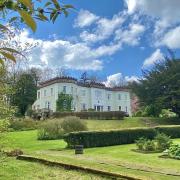By midsummer, the Herb Garden at Acorn Bank has completed its startling annual transformation. Visit during the winter and you’ll find a formal winter garden, straight gravel paths and well-behaved borders of dormant plants, cut back, weeded, mulched and tidy.
Step into the herb garden during the summer and it is hard to believe it is the same space. The trees are in leaf and perennial herbs flushed with green vigour and topped with flowers and seedheads crowd a space so full that barely a few metres ahead are visible.
The atmosphere is transfixing, relaxing and hypnotic. At this time of year, the garden team often finds visitors dwelling in the space below the Portuguese quince with a dreamy look, reluctant to move. Peculiar to this part of the garden at Acorn Bank, it makes you wonder what causes this effect. Could it be the echoes of history at the garden in the Eden Valley, which was once owned by the Knights Templar?

Or perhaps the sense of serenity imparted by the 400-year-old stone walls which surround the herb garden? Maybe the intensely natural feel of the ancient plant species growing here is more likely, attracting insects which hum and buzz gently. Or is there something about the medicinal plants growing here which affect visitors?
It is likely to be a combination, but the medicinal herbs that have been growing here, in the biggest herb garden in the National Trust’s care, since Graham Stuart Thomas instructed their planting in 1969, are definitely worth special attention – and a little caution.
The team of staff and volunteers at Acorn Bank takes extra care to wear long work gloves, sleeves and trousers when they weed in the herb garden. Cautionary tales of yellow Northern wolfsbane, which grows below the damson trees, being stuffed into carcasses of dead sheep and left out for wolves, or the sedative effect of the unnaturally white berries of baneberry on their blood red stems may well be the cause of their care.

It is also sensible to take care in the presence of alkaloids within Scopolia, the first herb to flower in March below the grapevine on the ancient, heated wall, which can cause a zombie-like state and has been abused by criminals over the centuries to persuade their victims to quietly hand over valuables or commit further crimes.
Perhaps the garden team is conscious of the self-seeding habit of deadly nightshade. Its botanical name, Atropa belladonna, speaks volumes about its past uses, having been a cosmetic eyedrop ingredient to widen pupils, for beautiful (bella) women (donna).
Less attractive are its poisonous qualities, said by the Greek goddess Atropos to be able to ‘cut the thread of a person’s life’.

Birds seem to enjoy its attractive shiny black berries though, turning up all over the garden – this year, it is happily growing behind the yew hedge in the Walled Garden. The berries’ juicy appearance is no doubt part of the problem, but it only takes a few to cause some very unpleasant symptoms. Rumour has it that Roman Emperor Augustus was murdered by his wife using the juice from deadly nightshade berries.
Plants have been used for mischief and murder for centuries. Several of the plants growing at Acorn Bank have found themselves on arrow tips for hunting or warfare.
Monkshood, a close relation to the prized garden delphiniums and equally beautiful, with stems four-five feet tall and topped with purple blue, hooded flowers, grow in a shady spot, not too close to the path. The darker side to its personality is the aconitine within, which can cause heart failure.
As well as being used on arrow heads, aconitine is responsible for the murders of Alexander the Great and Ptolemy, and even made its way into literature when James Joyce put it to work in the suicide of Rudolph Bloom in Ulysses.

Another plant pressed into use for poison arrows was veratrum, which was used by Native Americans who derived juice from the plants’ roots to dip their arrowheads in.
Veratrum has another side; in Chinese herbalism it is known for its emetic qualities. However, it is rarely used in this way, as it is considered too dangerous. Topical applications are considered less risky, and veratrum has also been used to kill external parasites such as scabies.
Of course, the reason the herb garden is full of plants with attitude is because, in the correct dose and prepared appropriately, these plants have long been used for their medicinal properties.
Some of the herbs growing at Acorn Bank have earned their place through an idea called the Doctrine of Plant Signatures, which suggests that a plant may be able to cure an illness if it has a physical characteristic which looks like the relevant part of the body.
The belief was that this physical similarity was a sign from God to help us find useful plants. So, lesser celandine, or pilewort, grows tiny lumps on its roots like miniature potatoes which signified its potential to be used to treat piles.

Hepatica, or liverwort has greasy looking leaves with three lobes, just like the liver. By this logic, it was deemed to be useful as a treatment for liver disease.
Some have stood the test of time, finding their way into modern day medicines. Foxglove was favoured by wise women responsible for treating illness in medieval times, when it acquired the nickname ‘witches’ glove’. A concoction of foxglove with other highly poisonous plants gained a reputation for causing hallucinations of flying and may have contributed to whispers that witches could fly.
By the 1600s, famous herbalist and physician Nicolas Culpeper listed foxglove as a treatment for epilepsy and for an itchy head. Now, after much scientific research, the digoxin contained in foxgloves is recognised and used medicinally to treat heart conditions – it can slow an excessive heartbeat and strengthen heart contractions during heart failure.
It is fair to say that most gardens do not contain Scopolia, deadly nightshade or veratrum. But many gardens will feature a variety of plants that have chequered and mischievous reputations.
From laburnum to hyacinth, potatoes to rhubarb, it is worth knowing your onions when it comes to poisonous plants.
nationaltrust.org.uk/visit/lake-district/acorn-bank



























